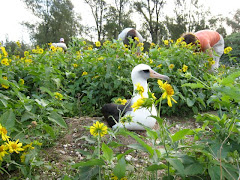Aia ka mo’olelo i ka ‘aina (The story is in the land)
Wednesday, June 10, 2009
The Papahānaumokuākea ‘Ahahui Alaka’i (PAA) workshop began today with a trip to the windward side of Oahu where all the PAA participants finally got a chance to meet each other and start forming our bonds for our upcoming adventure to Midway. After a brief orientation at Windward Community College, we were shuttled to Coconut Island, and the Hawai’i Institute of Marine Biology (HIMB). If you’ve seen an episode of Gilligan’s Island, you’ve seen Coconut Island. (It’s the island shown in the background during the opening credits of the show.) When we left the island today, we asked our boat captain to take us for a spin around the island. He agreed and proceeded to circumnavigate the island in about 3 minutes. Don’t let the size of this little island fool you... it is jam-packed with science and some of the highest technological equipment I’ve ever seen.

The photo of the day goes to Dr. Chuck Burrows (age 76), a retired educator who is spear-heading efforts to restore Hawai’i’s largest wetlands to its original status. Chuck introduced us to the 450-acre wetlands site with a hike and a stewardship activity designed to familiarize us with his restoration efforts to remove invasive plant species and reintroduce indigenous species.
Final Day of Preparation and Departure for Midway
Friday, June 12, 2009
Our last day in Honolulu focused on final preparations for our voyage to the Papahānaumokuākea Marine National Monument. As this week has progressed, there has been an absorption of the culture and heritage associated with the Northwestern Hawaiian Islands, and today I truly began to feel what the locals refer to as the “Aloha” spirit. Each day of the workshop began with a Hawaiian pule (prayer) asking for guidance and knowledge as we prepared for our journey to the monument. Each day, we met with policy officials and Native Hawaiians to learn about proper protocols and beliefs. Each day, we were surrounded by wise stewards who are passionate about their research and their contributions for sustaining Hawaiian history and culture for generations to come. We have been charged with their honor, challenged with their commitment, and blessed by their guidance for this journey. We are humbled to have this privilege granted to us that we might learn from Papahānaumokuākea and transfer this knowledge back to our own communities.
 Before leaving for the airport, we had an opportunity to meet another group of voyagers and help them to load their vessel for a journey to one of the neighboring islands. The Hokule’a (shown in the today’s photo) is a two-masted outrigger canoe used in education/outreach programs and has played a pivotal role in bringing ancient Hawaiian culture back to a new generation of Hawaiians. The canoe’s design is based on the original voyaging canoe design used by the early Polynesians who traveled to these islands centuries ago... before GPS... before satellite navigation systems... before radar. These brilliant voyagers traversed the oceans using celestial navigation and interpreting wave deflections and local bird knowledge to infer the location of islands in the sea. In 2012, the crew plans to circumnavigate the globe with Hokule’a while providing education
Before leaving for the airport, we had an opportunity to meet another group of voyagers and help them to load their vessel for a journey to one of the neighboring islands. The Hokule’a (shown in the today’s photo) is a two-masted outrigger canoe used in education/outreach programs and has played a pivotal role in bringing ancient Hawaiian culture back to a new generation of Hawaiians. The canoe’s design is based on the original voyaging canoe design used by the early Polynesians who traveled to these islands centuries ago... before GPS... before satellite navigation systems... before radar. These brilliant voyagers traversed the oceans using celestial navigation and interpreting wave deflections and local bird knowledge to infer the location of islands in the sea. In 2012, the crew plans to circumnavigate the globe with Hokule’a while providing educationWe departed Oahu around 5:00PM with all the well-wishes our hearts could hold and arrived at Midway after 9:00PM. As we touched down on the runway, our heads were pressed into the windows hoping to penetrate the darkness that shrouded the island and all of its inhabitants. As we were shuttled to our rooms via golf carts, albatross chicks and their parents flanked our pathway as if honoring our arrival with their presence. After a quick stroll to the beach by flashlight, we headed for our beds and some much needed rest. It seems so much like Christmas eve, as we anxiously await the morning light to see all the surprises laid out before us. I have never seen 12 educators so excited to be in the same place.

















It was super to get onboard the Hokulea befre our plane trip over the open pacific ocean...this gve us a taste of how the ancient Hawaiian traveled across the oceans...even as we were preparing to do so at 24,000 feet. Would the traditional way bring us closer to the Aina (land)?
ReplyDelete